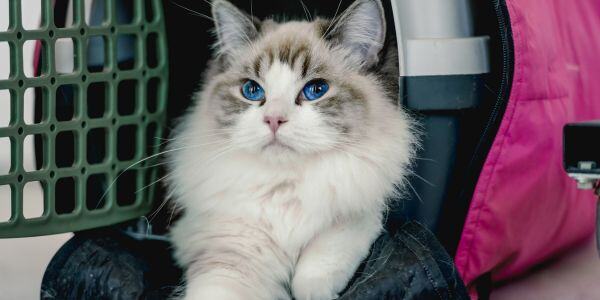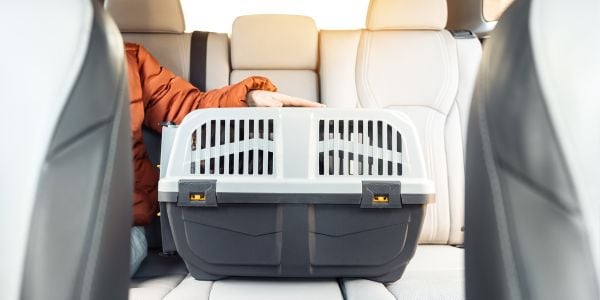 I am one of those unfortunate people who gets sick in just about any type of moving vehicle, be it a car, a bus, or a boat. I absolutely dread the feeling and the associated actions that accompany it. So, I very much understand the anxiety cats can feel prior to travel, and I truly sympathize with their misery.
I am one of those unfortunate people who gets sick in just about any type of moving vehicle, be it a car, a bus, or a boat. I absolutely dread the feeling and the associated actions that accompany it. So, I very much understand the anxiety cats can feel prior to travel, and I truly sympathize with their misery.
Therefore, I believe in trying everything and just about anything to help prevent both the issue of anxiety and carsickness. Let’s explore some options that may help your cat with their stress and nausea.
How to Lessen Cat Car Anxiety
If your cat is stressed or anxious most of the time, and it isn’t just car-related, I would strongly recommend consulting with a veterinary behaviorist or a certified feline behavior consultant. It is important to have the cause of your cat’s stress and anxiety determined and diagnosed so the appropriate treatment and management can be prescribed. Without this, it is unlikely that you can manage your cat’s car anxiety alone.
Cats who remain continuously stressed or anxious are at risk of developing other medical problems such as urinary tract, digestive, skin, and cardiovascular issues. The sooner you get a diagnosis, the better off their overall health will be.
If you happen to have a ‘happy-go-lucky” cat that is calm, cool, and collected until they know that a car ride is coming, consider taking one or more of the following steps to help ease the issue.
Proper Carrier Selection
You must select a carrier that makes your cat feel safe and secure for their car ride to lessen stress and anxiety. It is never a safe nor good idea to let your cat have the run of your vehicle, no matter how much more comfortable they seem when not confined in a crate or carrier.
Check out our tips and cat carrier recommendations to help you select the best option for your cat.
Carrier Acclimation
Your cat’s car anxiety begins long before they ever reach the car, and it all starts with the carrier. If cats are not properly acclimated to the carrier, the process of getting them into it and keeping them in there creates significant stress and anxiety. Just think how you would feel if someone chased you around and stuck you in a box.
If this is part of your cat’s car anxiety, I suggest checking out this article that gives you helpful tips on how to make your cat’s carrier a friendly place.
Calming Supplements and Alternatives
I am a big fan of calming supplements and alternatives since they are easy to use, don’t require a prescription, and are generally safe. However, it is important to keep in mind that calming supplements and alternatives do not work for all cats, and you may need to combine a couple of options and possibly along with behavior modification (explained more in this article) to get the desired effects.
Calming treats for cats: These are great and can be used both before and during travel. Typically, it is recommended to give these about 60 minutes before travel.

Probiotics: If you have advanced notice for travel – say 4 to 6 weeks – you should start your cat on probiotics to help keep them calm and aid their gastrointestinal tract from stress. Purina Calming Care is a great option, and there other probiotics to consider, depending on you and your cat's preferences.
Feliway pheromone spray: A couple of sprays of this calming pheromone on the towel or mat in your cat's carrier could be just what they need to feel less stressed and more comfortable with travel. Note that with pheromones, a little goes a long way. Don't overdo it; more is not better. You will want to spray the carrier, towel, or mat (never your cat) as well as the car about 30 minutes before leaving so that it is completely dry and there is no residual alcohol smell.
Catnip as a distraction aide: Catnip spray to spritz their toys and catnip to sprinkle in their carrier; both can provide some distracting entertainment for your cat and a nice little "high" that could help reduce their anxiety. Read more about catnip.
Thundershirt for cats: Some anxious cats respond really well to the compressive and comforting nature of these anti-anxiety jackets. You'll want to test it out on your cat well in advance of your departure date and even do some of your "test drives" with them wearing their new jacket.
Home sweet home smells: Place a t-shirt with the scent of their favorite family member in their carrier. The familiar and comforting scent can help ease some anxiety and provide comfort and security. It's also helpful to use a blanket or mat your cat has slept on. Being surrounded by their own scent is comforting, too.

Car Prep
Before you put your cat in the car, be sure to cool or warm it so the environment is a comfortable temperature. Your cat will feel more stressed if the temperature isn’t comfortable for them. This is also a good time to spritz the car with a calming pheromone.
You want to place your cat’s carrier securely in the middle of the back seat to avoid it shifting around. This not only helps with anxiety but helps with carsickness.
Some cats benefit from covering the sides of the carrier with a towel or blanket. Just make sure there's enough airflow.
Some cats also benefit from and respond to calming music to help reduce their anxieties. And, who knows, it may just help make the drive more pleasant for you, too.
Medication
Ah, the best-laid plans... It's possible that even if you take all of the precautions and steps outlined above to condition your cat to car travel, they may still be stressed in spite of your best efforts. At this point, you need to consult with your veterinarian about medication to calm your cat’s car stress and anxiety.
Be sure to speak with your vet well in advance of your expected departure date, as your kitty may need a current exam, and doing trial or test doses is often necessary to determine what the best and most effective dose or combination will be for your cat.

How to Prevent Cat CarSickness
Just like with anxiety management, this process starts well before the car ride. If your cat is anxious before they get into the car, they are more likely to get sick while traveling. So, work on managing pre-travel anxiety.
Since the symptoms can be similar, it can be hard to differentiate between your cat being anxious and having carsickness.
The following are some signs that indicate that your cat may be experiencing carsickness:
- Excessive and loud meowing and howling
- Restlessness
- Excess yawning
- Licking lips excessively
- Heavy drooling
- Diarrhea
- Vomiting
If anxiety is the prime issue, symptoms of stress will exist before, during, and/or after travel, whereas with carsickness, the symptoms cease when the car stops moving.
Car Acclimation
Acclimate your cat very slowly to the car. If they feel less stressed in the car, then it can subside the symptoms of carsickness. Read here for tips and the steps to getting your cat comfortable in a car.
Food Timing
The likelihood of a cat getting carsick and vomiting can be reduced by not feeding them for a few hours prior to the car ride – at least 2 hours. Now, this won’t be super practical for a multi-day car trip; after all, kitty has got to eat at some point! But, if just a one-day trip or a drive to the vet, this might help.
Carrier Size
The size and type of carrier, as well as how acclimated to it your cat is can impact your cat’s carsickness. Every cat has their own preference when it comes to carriers. But if you have a cat that gets carsick easily, you want an easy-to-clean carrier.
For my cats, as well as for some of my patients, using an oversized carrier (like a plastic canine carrier for airline use) with a comfy bed, a familiarly scented piece of clothing, and a litter box in it helped lessen stress and carsickness. Unfortunately, this isn’t always practical because of the lack of car space, but if you can fit a carrier that big, it is worth a try. Desperate times call for desperate measures!
We have travel-sized carrier and litter box recommendations.
Carrier Placement
Be sure that the carrier is facing forward in the middle of the backseat and is very securely fastened so that there is little to no movement. A wobbly carrier leads to further anxiety and motion sickness.
For some cats, also covering the sides of the carrier with a blanket or towel can be of further help in preventing motion sickness. Just make sure there's enough airflow by leaving the front door uncovered.
Natural Remedies
There are some natural remedies that may help, such as Rescue Remedy for Pets, valerian, ginger, chamomile, or skullcap. Even though they are deemed safe, never use any of these without first consulting with your veterinarian.
Prescription Medication
In addition to the above steps, I strongly recommend talking to your vet about the medication specifically designed to help prevent carsickness and vomiting, such as Cerenia. Additionally, your cat may also need anxiety medication, so be sure to discuss that with your veterinarian as well.
You likely can’t completely eliminate all your cat’s anxiety or always prevent carsickness, but working towards this goal will definitely benefit you both.



